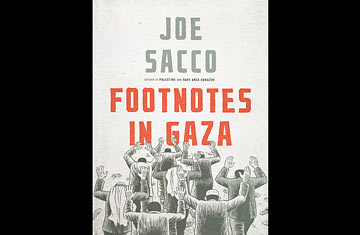
Joe Sacco Footnotes in Gaza
Joe Sacco's Footnotes in Gaza is a comic book like no other. It has no super-heroes, and not many laughs, but few would expect much levity in a story set in a territory under constant siege and bombardment by the Israelis. But Gaza's present plight simply forms the backdrop against which the book's main character, the cartoonist himself, wanders through 388 finely-crafted pages, dodging Israeli missiles and sniper fire as he tries to re-construct events surrounding two massacres of Palestinians in Gaza by Israeli soldiers in 1956.
Sacco's project leaves many Gazans dumbfounded, sometimes even angry: 1956 was a long time ago, they keep telling the American author, as Israeli choppers fire cannons at fleeing militants and bulldozers tear down Palestinian homes deemed too close to Israeli positions. Why not write about the here and now? But Sacco is as dogged as a noir detective; he never gives up after being told by an Islamic militant that one of the massacres, in Khan Younis, had "left a wound in my heart that can never heal... (They) planted hatred in our hearts."
This explanation has a certain weight, coming from Abed El-Aziz el-Rantisi, who, as Sacco explains in the prologue, is a senior figure in Hamas later assassinated by an Israeli rocket. And in the course of his investigation, award-winning cartoonist-reporter Sacco, who has published works on Bosnia and the Palestinian territories, makes a convincing case that these two mass killings — "foot notes" which rated only a few sketchy lines in UN dispatches and press reports of the day — are key to understanding the despair and rage of 1.5 million Palestinians trapped inside Gaza today.
In one of the early scenes, at a boozy Jerusalem party of jaded journos, Sacco muses that "They could file last month's story today — or last year's, for that matter — and who'd know the difference?" That's sadly true; a British colleague of mine once accidentally sent the wrong computer file to his editors in London, who dutifully ran his stale Gaza story without noticing that they'd run the same piece a week before. There is a numbing sameness to stories about Gaza, but Sacco's illustrations, backed by his methodical research, bring the Gaza of 1956 bleakly to life, using the past to explain the present in a way that rarely makes it into today's news stories. He inks his characters and scenes with the same meticulous detail that he invests in his reporting.
[Sacco reminds us, for example, that the vast majority of Gazans are refugees driven out of their homes on Israel's coastal plain in the war of 1948, and barred from returning. And in one of the most startling observations in the book, he shows that Israeli leaders understood exactly why the Palestinians of Gaza would turn to violence. He quotes General Moshe Dayan, Israel's most celebrated military commander, at the April 1956 funeral of a kibbutznik slain by Palestinian fedayeen near the Gaza border, warning Israelis that they faced an intractable conflict that they had no choice but to fight . "Let us not cast the blame on the murderers today," Dayan said at the funeral. "For eight years they have been sitting in the refugee camps in Gaza, and before their eyes we have been transforming the lands and the villages, where they and their fathers dwelt, into our estate... Let us not be deterred from seeing the loathing that is inflaming and filling the lives of the hundreds of thousands of Arabs who live around us. Let us not avert our eyes lest our arms weaken." Dayan's view that Israel's survival depended on crushing any effort by the Palestinians to regain by force of arms that which they'd lost in the war of 1948 shapes the thinking behind the 1956 operations in retaliation for fedayeen raids from Gaza that form the focus of the book — the same logic that was at work in last year's Operation Cast Lead.]
